|
unit 9 Teaching writing

strategies, types of writing, grading writing, ...
notes about writing 기본개념에서 writing 은 다른 영역과 다른영역으로
가장 중요한 것이 “organization“ 부분이다.
의사소통을 위한 여러형태의 writing 종류가 있고, writing의 기타 역할로 학습을 돕고
기억을 돕는다는 것에 테솔 공부를 하면서 공감을 하고있다.
wrting strategies 에는 what & why를 분명히 하고 유익한 transition들을 알아두는 것이
필요하며,
F.A.N.B.O.Y.S 약자로 필수 transition을 소개해주는 것이 신선하면서도, 재밌고 기억이 잘 되는 것 같다.
기타 Punctuation, spelling, Organization, Form type에 대해 배운다.
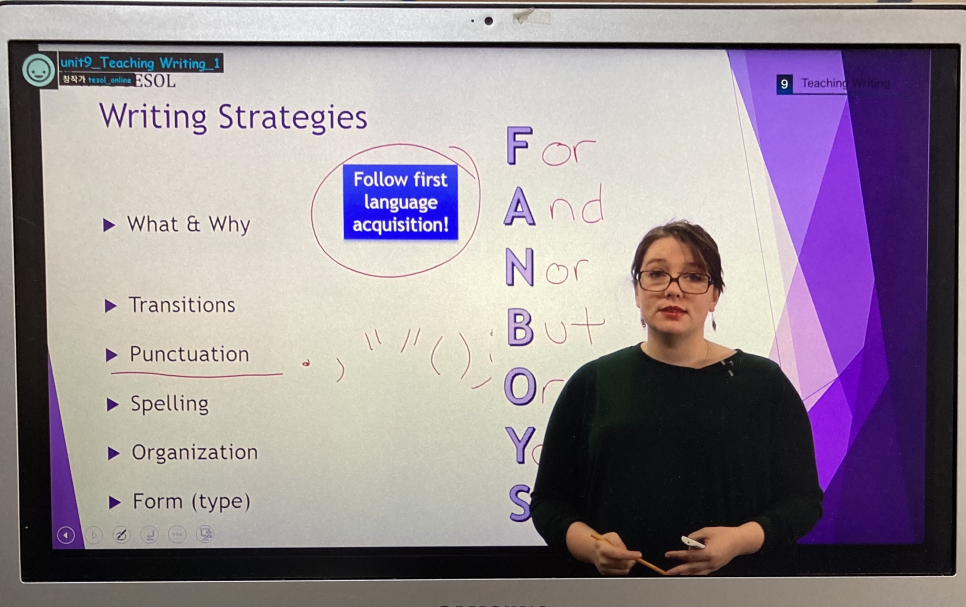

적용할 수 있는 guided wrting tasks들도 소개하고 있는데 ,
평소 다양하게 시도를 못해본 것이 느껴졌다.
scarambled stories, sentences등 다양한 방법을 학생들의 level을 고려하여
시도해보는 것이 좋을것 같다.
advanced 레벨에서 note-taking 활동으로 Ted-talks 소개와,
여러 관심 있는 주제를 다룰 수 있고 유익한 보강자료로 학습에 활용할 수 있음을 소개하고 있고,
실제적으로 이용할 수 있는 정보제공이 좋았다.
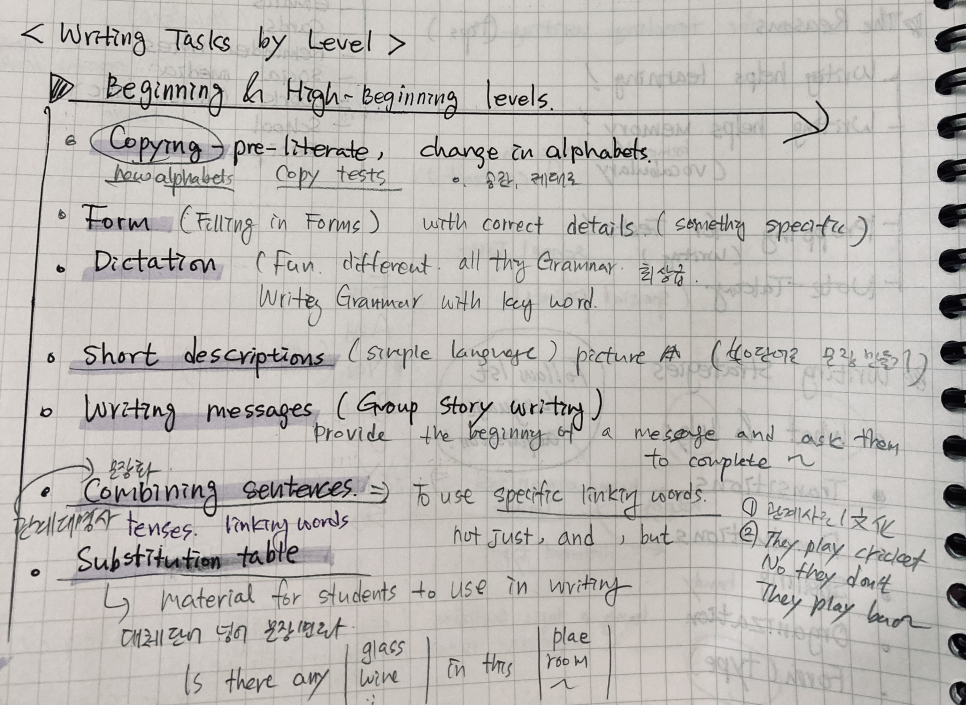
그리고 Grading writing 에 있어서, 개인적으로 Bea 선생님의 인상적인 강의 부분은,
“ Don’t correct to your students’work for them !! make them do the work. “이다.
그렇게 할 수 있는 system을 소개한다.
그중 color부분에서 그는 학습자의 심리적인 면을 먼저 고려하여
”don’t use red color! (angry color), 우리 교육현장에서 가장 많이 사용하는 red를 오히려 비추천하고 있다.
( 우리 현장에서는 학습자의 심리보다는 오답이라는 사실 확인 강조를 위해
red 사용이 관례가 된 것 같아 무엇을 우선으로 생각하는지 사고의 차이점이 느껴졌다.
개인적으로 angry colors를 피해, 추천해주시는 Happy colors을 많이 사용해보기로...)
review 문제풀이를 통해 writing이 어떤 부분을 발전시키는데 도움이 되는지도 알수있다.

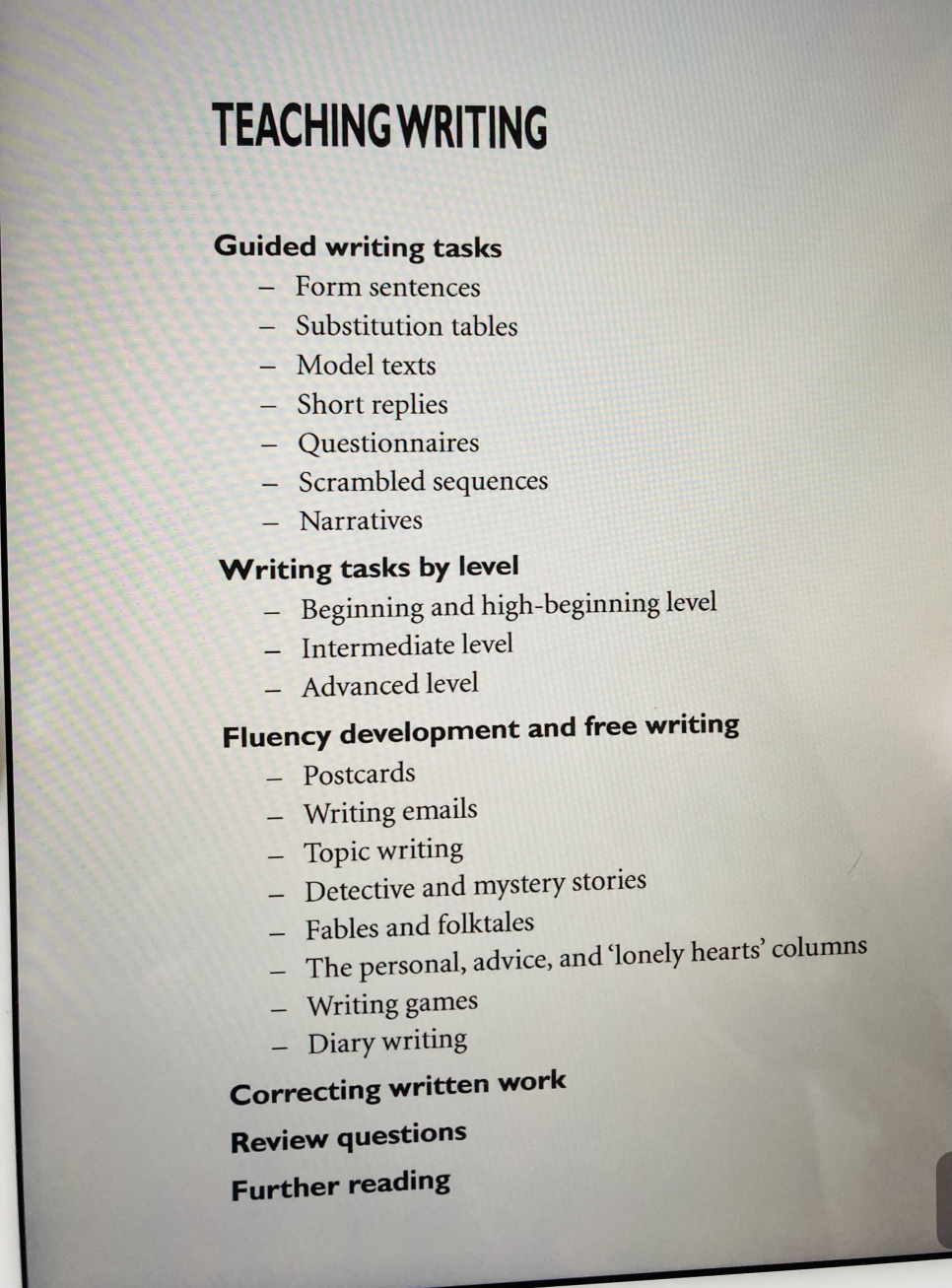
부교재파일 Chap10 Teaching writing 참고
unit 10 Teaching speaking

이 유닛에서는 teaching speaking, teaching pronunciation의 먼저 소개하면서 시작한다.
무엇을 지향하는지 공통점과 차이점들을 알 수 있다.
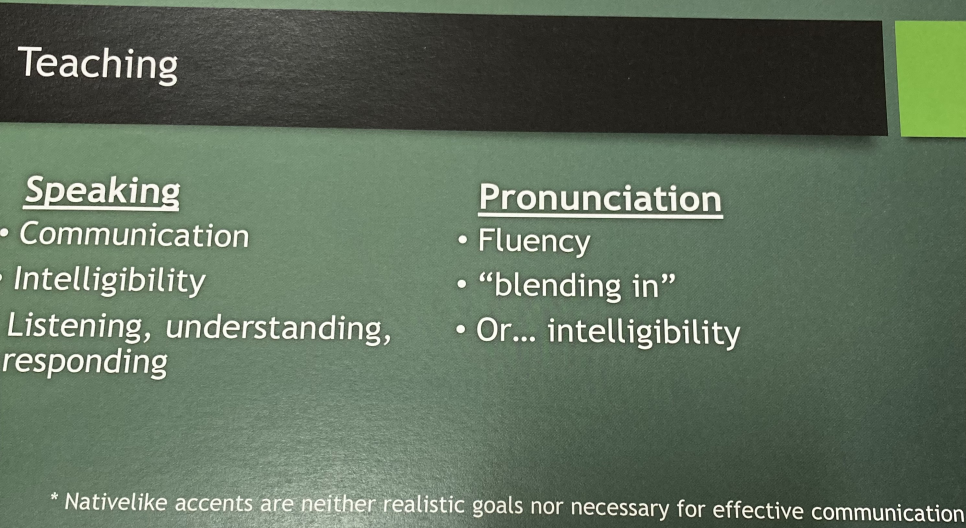
teaching pronunciation파트에서, The internatioal phonetic alphabet (IPA)를 통해
제2외국어로서 영어를 학습하는데 발음정보를 재정리할 수 있다.
(단, ipa는 학생들이 발음을 어려워하는 초급대상자들보다는
좀 더 시간을 투자할 수 있는 아카데믹한 클래스에서 시도하도록 추천하고 있다)
teaching speaking파트에서는 speaking의 목표가 communicating meaning부분임으로
주의해얄 부분이 바로 T.T.T (teacher talk time)을 줄여
학생으로 하여금 더 의사표현을 할수있도록 상황을 제공하는 것이다.

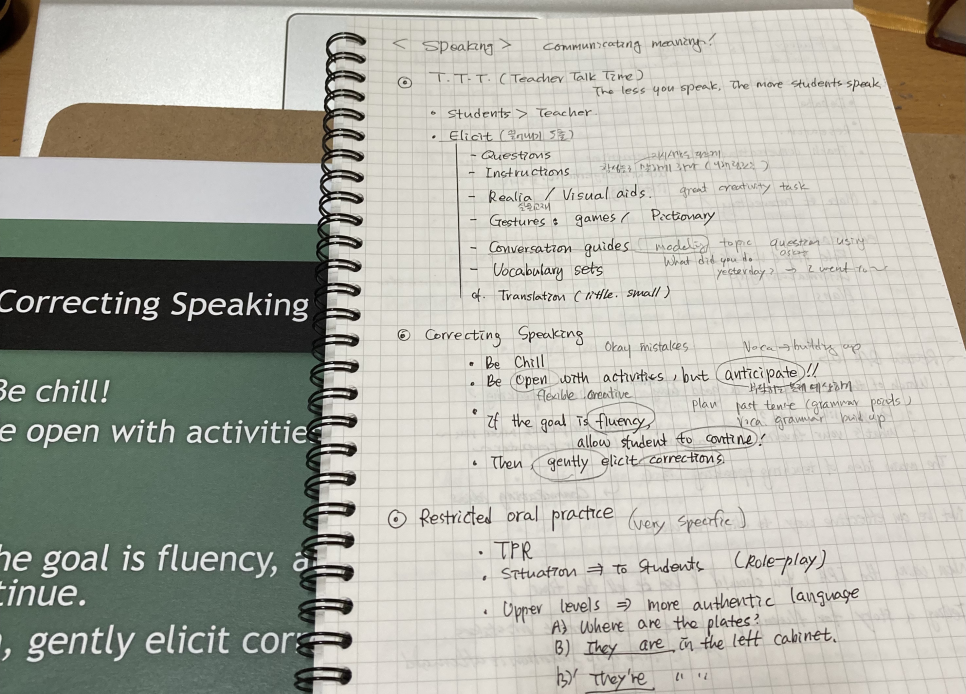
“The less you speak, the more students speak ”
correcting speaking에서 배운 것은 (습관적으로 오류를 무조건 고쳐주려고 하는 습관이 있는데)
“ if the goal is fluency,
allow the student to continue (then, gently elicit corrections) "하라는 것이다.
cf. fluency v.s accuracy 따른 차이

부교재 chap 6
unit 11 Teaching listening

notes about listening 사항중에 많은 사람이 궁금해하는 것이
How many times? 횟수의 문제이다(2-3회를 추천)
Preparing listening에서 목적들, 연습되야할 skill들, level-appropriate한가,
핵심어휘들, 그리고 흥미를 가질 수 있는지 고려해야 할 부분들이 나온다.
authentic and creative한 자료들을 활용할 수있어야하지만
lisening을 발전시키기 위해서 와닿은 강의 내용중 하나는,
specific information을 위한 적합한 길이의 내용,
무엇보다 “Do this regulary !”라는 포인트이다.

listening Task의 예제가 제시되는데 부교재내용 (p.126-127)에
listening task의 각 참고내용이 서술되어 이해에 도움이 된다.
Implementing 관련 내용과 Listening Task로서 dictations 와
conversation , song activities의 강력한 장점들, 특징을 확인할 수 있다.
(listening source로 활용할 수 있는 구체적인 sample을 제시해줌으로 도움이 되었다.-The ballerina )

listening Task의 예제- 부교재내용 (p.126-127)
unit 12 Developing Materials
마지막12단원의 topic로는, 교실에서 가능한 types of visuals,
how to create good worksheets, kinds of games playing in the classroom,
how to use text resources등을 다룬다

types of visuals의 The board파트에서 공간에 너무 많은 정보를 채우지 않는다는 것
단순화시키고 학생들의 참여를 끌어내는 것 역시 학습자입장에서 생각해보는 관점이 와닿았다.
기타 materials들을 많이 다루고 있다.
photos, comics 등 realia (실재적,실물적)활용이 유익하고,
많이 사용하고 있는 projector, videos, worksheets 사례들을 소개한다.
(개인적으로 어린 학생들에게는 쉽고 흥미를 유발하기 좋은 pictionary,
그 외 경험 있는 학생들에게 Find someone who..워크 쉬트 사례를 좀 활용해보고 싶었다. )
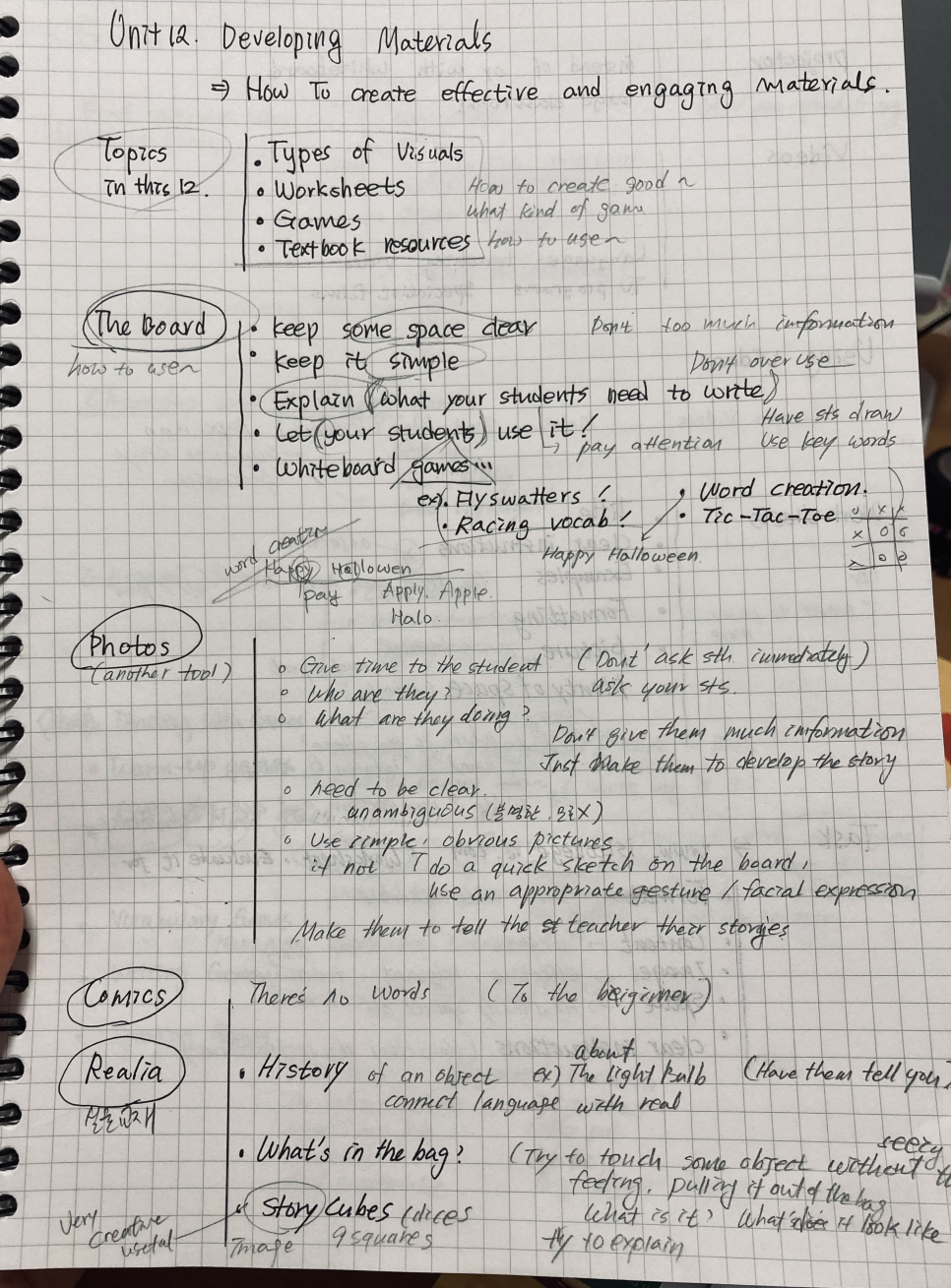

기타 Using textbook resources에서도 활용할 수 있는 activity를 소개하고 있다.
다양한 materials에 대한 관점으로 시각을 넒히도록 동기를 부여해주는 단원인 것 같다.
학생들의 학습목표와 상황에 맞는 자료들을 선택, 정보로 익숙하게 활용해볼수 있길 기대가 된다.
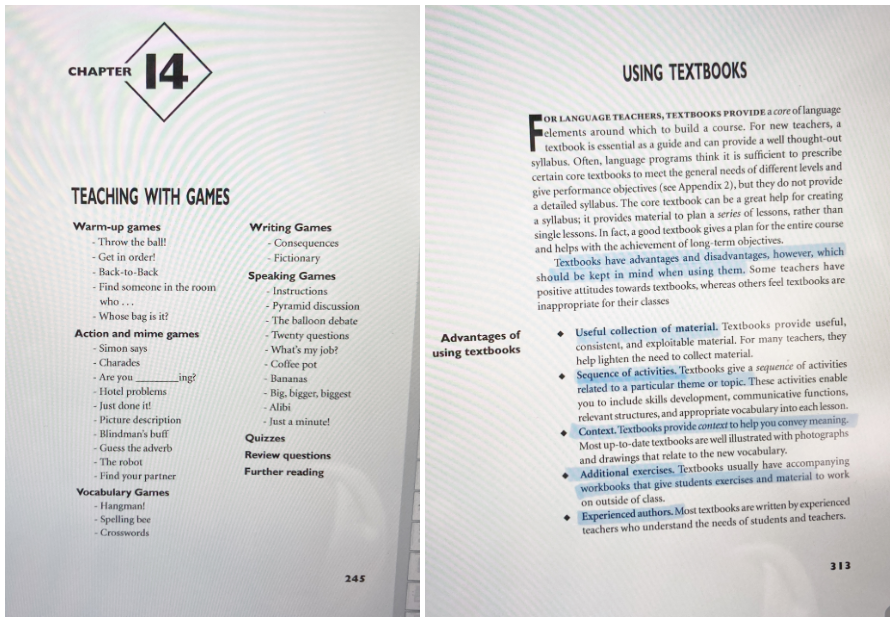 |